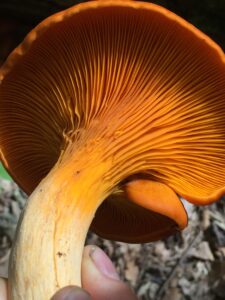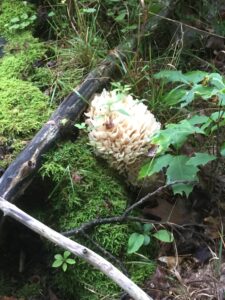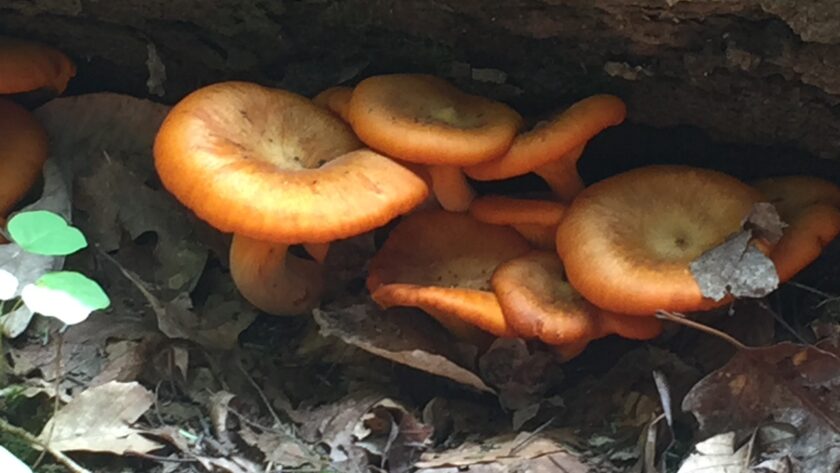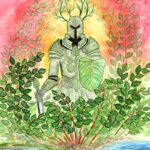Wild mushroom hunters have a term for how to see mushrooms in the forest–you need to get your “mushroom eyes.” This means that when I enter a forest with the intention of looking for wild mushrooms, I start paying attention carefully to the ground, to the fungal layer in the forest, and to particular patterns and colors. Mushrooms become all that I see. I look for different mushroom patterns depending on the time of year and what the weather has been–in the warm summer months, I might be scanning the trees higher for bits of white (oysters) or yellow (chicken of the woods); I will be looking carefully for bits of orange (chanterelles) or brown (porcini), or particular patterns. If I’m really perceptive, I might even see some elusive black trumpets, who look like decaying leaves and are nearly impossible to spot on the forest floor. I look for different mushrooms depending on a host of factors, including the ecosystem in the forest, the direction the hillside is facing, the weather, and the time of the year. And “mushroom eyes” are just one of many ways of seeing the forest. This post explores the concept of seeing the landscape around us–for it is only with seeing that we can move onto other forms of sacred action– regenerating, healing, and doing sacred work.

To show how important having ways of seeing our lands can be, I want to share a story. Last year, I went with a fellow druid friend to Costa Rica. One of the things we were really excited to do was to go into the rain forest–and up into the cloud forests we drove until we finally found one of the more secluded rain forests. Entering that rainforest was one of the most incredible experiences of my life–it was raining and misty, and the forest was full of these incredible layers of color, light, and sound. The rain forest was teeming with life; every tree was a mother tree hosting countless other plants, insects, birds. The elevation changes were quite substantial, rivets of water flowing down, flowering trees and moss and orchids growing up everywhere. On our journey deeper into the forest, we came across a couple hiking in the opposite direction. From the sound of their accent, it sounded like they were from somewhere in eastern Europe. The man, soaked to the bone because of the intense rains that day, said, “Nothing to see here. Anything up ahead?” I looked at him incredulously and said, “Everything to see here!” He shook his head and continued on. My friend and I talked about him afterwards: What did he expect? Fireworks? Monkeys throwing excrement? Natives swinging from the treetops? What a sad state we are in, thinking that the forest must entertain us.

The thing about my own seeing of the the forest in Costa Rica was that even to me it was full of mystery and unknowns. I didn’t know what plants were medicine or poison, the relationships between the plants, heck, I didn’t even know the name of anything in that forest! I was able to see to appreciate the forest (unlike the man we met on the trail) but I wasn’t able to see with understanding.
In order to interact, to regenerate, to heal our lands, we must first know what we are looking at. Before we can act, we must see and in order to see we must understand. How we see the world is how we inhabit it and how we interact with it. So let’s take a look at some of the ways we can see, both positive and negative. You might think of these ways of seeing like different lenses–when you put the lenses on, everything is colored by that experience.
Negative Ways of Seeing the Land
Negative ways of seeing the land do not lead to healing and regeneration, but rather, apathy or active destruction.
Unseeing eyes: Not seeing what is in front of you for a variety of reasons. This can be characterized by people who are not even looking: they have their heads in their cell phones (literally not seeing), their eyes closed, are sleeping, are looking down rather than at nature, are not willing to see or engage. This is the act of not looking.
Disconnected eyes. This kind of seeing is best characterized by the man in my story above, who enters a forest and says “nothing to see here” or “nothing to do here.” In this case, the person sees and is looking around, but can’t seem to see the forest through the thick of their own expectations.
Exploitative eyes. Another kind of “negative” seeing is a person who is looking at the forest with the goal of exploiting it or harvesting all of its resources: logging, mining, selling it for profit rather than necessity, and so on. We have a lot of this happening today, all over the world–nature is not valued for anything but its monetary value.
Antagonistic Eyes. The third kind of negative seeing is seeing nature in opposition to humanity: seeing the dandelions in the lawn as an enemy, or seeing a wild meadow as messy and in need of mowing, seeing thriving medicinal plants as weeds, and so on. This is the place where “weed” ordinances and other oppressive laws come from, and why neighbors get upset when you put a garden in your front yard!
Positive Ways of Seeing the Land
Positive ways of seeing the land can help us open up our spirits and our hearts to the wonder and mystery of the living earth.

Appreciation Eyes. The next level up the seeing chain is appreciation eyes–this is seeing the forest through an appreciative (but not necessarily knowledgeable) eyes, like how I saw the forest in Costa Rica. I appreciated its beauty and was happy to be there, but I didn’t see it with the knowledge of someone who understands it.
Awareness Eyes. Awareness happens when seeing is combined with knowledge. This is when you begin to learn about the land, your awareness is being raised. You can gain this kind of knowledge from participating in a “sit spot” activity where you do meditation and observation in the same spot over a period of months or years.
Mushroom Eyes. Your focus is set very consciously and mindfully on one particular part of nature; this focus requires some knowledge of the specified thing; hunting the mushrooms in the forest, paying attention to all the maple trees of any variety; birdwatching; looking for wild bees nests. This is what we do when we go foraging–we are looking at the forest in a particular way. This is what hunters do when they go out hunting, or birdwatchers do, or any other specialized group.
Interconnected Eyes. This way of seeing encourage us to see the inter-relationships and interconnectedness of all things. This also takes knowledge and keen observation. So you might observe the birds eating the fruits, the mycelium running on the forst floor, the cycle of water and light, and so on.
Sacred Eyes. Yet another way of seeing the forest is through sacred eyes, where we combine knowledge of the outer planes with knowledge of the inner planes, and we see in order to commune, communication, or be in solidarity with the land around us. When I go into the land to heal and work magic, I see it with my sacred eyes.
I think there are many other ways we can see the forest–through the eyes of a scientist, through the eyes of a child filled with wonder, through the eyes of someone who is seeing something for the first thing, and so on. The important part here is that all of these ways of seeing are cultivated and it is through that cultivation that we can raise our own awareness of the living earth.
As a druid, I always seek a tertiary, a balance between two extremes (like negative or positive). But I question whether there is a “neutral” way of seeing; everything we see is wrapped up in our values and judgements. Its a useful exercise to try though, just to see without assigning value, knowledge, emotion, or judgement for a time. One of the ways I achieve this tertiary is, believe it or not, to take off my glasses. Then I see things quite differently! Another way of doing this is consciously separating what you see from what you think (when I teach observational research methods, we use a simple double-entry notebook that encourages us to place direct observations on one side, and thoughts/assumptions/conclusions on another). Its not that this makes us neutral, but it does make us more conscious of how we are observing.
Cultivating Mushroom Eyes
As you may have noticed, many of the positive ways of seeing I’ve listed above are through careful cultivation: through experience, knowledge, and interaction. Spiritual traditions and teachings have often focused on cultivating our most basic skills, such as seeing, because deep awareness can come through simple, daily or weekly practices.

Observing nature. One of the most powerful things you can do to cultivate a deeper awareness is simply observe nature regularly. One of the core AODA practices is spending 15 minutes minimum, each week, observing nature. This practice involved stillness where you would sit, keeping an empty mind, and sit in quietude with nature. The other part of the practice involved focus where you close attention to one particular thing–petals on a flower, the ripples on a pond, the rustle of the leaves, the veins on a plant, a squirrel hoarding nuts, and so on. This simple practice, over a period of years, revealed so much to me, and I continue it to this day. The most amazing thing about this practice is that there is always more to see and learn through observation. This summer, I spent a period of time each day observing the flowers on plant known as all heal (prunella vulgaris); after a set of days, I realized that their flowers bloomed in a particular pattern aligning with sacred geometry. Now, when I use that plant as medicine, I have a much deeper awareness and understanding–all through the simple yet profound practice of observing nature.
The Sit-Spot. Another take on the observation of nature is using a “sit spot.” This is a spot that you return to, frequently, and observe often. The nice thing about the sit spot technique is that it allows you to develop an understanding of how the patterns of nature change with the weather, with the seasons, with night and day. My sit spot for many years was on a smooth, large stone by my pond in Michigan. For five years, I went to that spot regardless of the weather–I especially enjoyed it at night, and in warm summer rains. Going to the spot when it was raining or snowing gave me a completely different perspective from when it was sunny.
Reading books and seeking knowledge. Part of developing your eyes is filling your mind with knowledge that you can then apply to the natural world, through observation and interaction. So get some good books on your topic and read away. A few books I really like are a set of books by John Eastman, called The Book of Swamp and Bog, The Book of Forest and Thicket, and The Book of Field and Roadside. These books are wonderful for teaching you not just about identification (which any field guide will do) but about the interrelationships of plants, animals, and insects. For foraging , I have some of my favorite books listed here.
I hope that this post has you reseeing the world around you!


Beautifully written! I talk my dog to the dog park every day and while I repeatedly throw the ball for him to catch I ground myself to the earth and sit in the same spot, looking at the changes of natural all around. It is a time I treasure and the dog enjoys it, too! Thanks for your thoughts.
Sorry for the typos! “take” my dog and “nature” all around
Sounds wonderful, David! Thanks for the comment
Love this. If more people would really see, understand, know, learn the interrelatedness, and feel the sacredness of Earth, maybe we would start taking better care of Her.
That’s the hope, right? I think its all about cultivating that relationship and taking every opportunity to help others do the same! <3
<3
Absolutely brilliant post, thank you. I’m working on my “nature awareness” for my ADF work at the moment, which is similar to the AODA practice of going to the same spot and observing nature. I’m still at the “appreciation” stage, but hopefully I’ll gain more knowledge as time goes on. I look forward to seeing some of your more AODA focused posts as they are a tradition that have always interested me, and congratulations on the very impressive sounding new role!
Thanks for the comment, Ryan! What does ADF do for nature awareness?
Nature Awareness is a required part of the Dedicant Path, which is their first level of training. In the textbook I have, you’re encouraged to visit a natural place at least once a week and observe how it changes over the course of one full year (kind of like the “sit spot” you describe). You’re also given questions to look up about your local ecology, such as where your waste goes, where your water comes from, what type of soil you are on, what crops grow in your area etc. to get more in touch with your immediate surroundings and start thinking ecologically. Then you have to write that all up in an essay (I haven’t done this bit yet). I know ADF sometimes is seen as deity-centric instead of nature-focused but honestly, the Nature Awareness “homework” has definitely changed how I relate to my local area and its flora and fauna!
I’m so glad that these practices helped :). That’s how I got started on this as well–about 10 years ago, 15 minutes observation and meditation in nature + 3 meaningful changes. Its amazing where that can lead!
[…] and butterflies are mostly gone, and many birds have migrated south. Dana recently wrote an excellent post on her blog in which she described the concept of “mushroom eyes” and … I love that term, “mushroom eyes.” Pick one thing (whether it be mushrooms, […]
Reblogged this on Rattiesforeverworldpresscom.
Thank you for the reblog!
I so appreciate that you share your wisdom